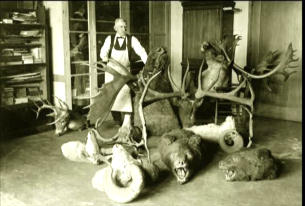

 The Accurate Reloading Forums
The Accurate Reloading Forums  THE ACCURATE RELOADING.COM FORUMS
THE ACCURATE RELOADING.COM FORUMS  Hunting
Hunting  Taxidermy
Taxidermy  Question about horn coloring
Question about horn coloringGo  | New  | Find  | Notify  | Tools  | Reply  |  |
| One of Us |
Just received my mounts and skull mounts back from SA. I had told the taxidermist to leave all horns natural. Of course, when I opened the crate the Wildebeest and Kudu horns have been "painted black" or whatever. I realize there is not much I can do now, but why do they do this? Their own invoice says to leave them natural....but.... I don't want to open up a long distance case of he said she said or griping but with all the overall beauty, I will always look at them and get p'oed just a little. The funny thing is they left the Eland and Impala horns natural! Any information would be appreciated. | ||
|
| One of Us |
Replied at 24hr, but you can search (Find function) for more of my experiences, as needed. _______________________ | |||
|
| One of Us |
Most African game horns are boiled to the point they have the oils of the karetin ( the horn ) burned and it is leeched to the surface. They do this to remove the sheath and clean the inner core. Just like the stupid taxidermist here in the states that boil sheep horns off the cores they turn very dark.The African horns turn dark or black when they boil to long and to hot. So they just add more black paint near the base to make it all look the same where it meets the skin on top of the head. The only thing that can be done is the complete repainting for the horn. Base coat them white with Kilz stain blocker and start from scratch and airbrush them. | |||
|
| One of Us |
Thank you for the explanation. It makes sense now. I'll shut up. Again, thank you. Mr. Kudu is now resting on my wall where he shall stay. And he's looking at Mr. Wildebeest across the room. | |||
|
| One of Us |
ftg767, Don't be too dismayed. This is typical. My kudu had beautiful chocolate colored horns when alive. When I received it here in the States, they were almost black and very dull from boiling. My kudu is a pedestal mount, and when I look at it, the horns bug me. (The horns are removable) I have a new taxidermist who says he can color them back to the original color, and then he'll put bees wax on them to give them back their natural satin sheen. I'm looking forward to having that done. | |||
|
| One of Us |
To retain the original color (FWIW) kudu horns have to go through a maceration step. This is basically letting the skull portion soak in water, that must be changed out, until they loosen (rot?) due to bacterial action. This is WAY too involved for today's high volume safari trade, thus the boil 'em all in an iron bathtub over a wood fire approach that yields black horns. My taxi over here immerses the skull in clear/clean boiling water and used a burner ring (propane) instead. At least that's how he was doing a blackbuck skull+horns. _______________________ | |||
|
| Powered by Social Strata |
| Please Wait. Your request is being processed... |
|
 The Accurate Reloading Forums
The Accurate Reloading Forums  THE ACCURATE RELOADING.COM FORUMS
THE ACCURATE RELOADING.COM FORUMS  Hunting
Hunting  Taxidermy
Taxidermy  Question about horn coloring
Question about horn coloring

Visit our on-line store for AR Memorabilia

